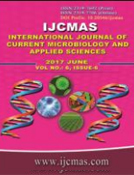


 National Academy of Agricultural Sciences (NAAS)
National Academy of Agricultural Sciences (NAAS)

|
PRINT ISSN : 2319-7692
Online ISSN : 2319-7706 Issues : 12 per year Publisher : Excellent Publishers Email : editorijcmas@gmail.com / submit@ijcmas.com Editor-in-chief: Dr.M.Prakash Index Copernicus ICV 2018: 95.39 NAAS RATING 2020: 5.38 |
Necrotic enteritis is an important bacterial disease of poultry caused by type A and type C of the enteric gram positive spore forming organism Clostridium perfringens. Necrotic enteritis suspected case was presented for necropsy from a dead guinea fowl. Gross examination showed ulcerative lesions in the intestine. Microscopically, necrosis and degeneration of the intestinal villi and mononuclear cell infiltration was noticed. Liver histopathology revealed that the mononuclear cells infiltration and perivascular cuffing in blood vessels. The causative organism was isolated from the intestinal contents under anaerobic condition. The collected sample was processed and growth was achieved on tryptose – sulphite – cycloserine (TSC) agar, blood agar, clostridial agar, perfringens agar. Typical Clostridium perfringens colonies were identified by grams staining and further confirmed by biochemical characterization. For molecular confirmation genomic DNA was isolated from C. perfringens and amplified using 16s rRNA universal primer. Multiplex PCR (mPCR) was carried out for toxin genotyping and the isolate was found positive for α toxin (cpa), a characteristic feature of C. perfringens type A. The present report emphasizes the molecular characterization and toxin genotyping as a rapid tool for detection of C. perfringens from suspected necrotic enteritis cases in poultry.
 |
 |
 |
 |
 |